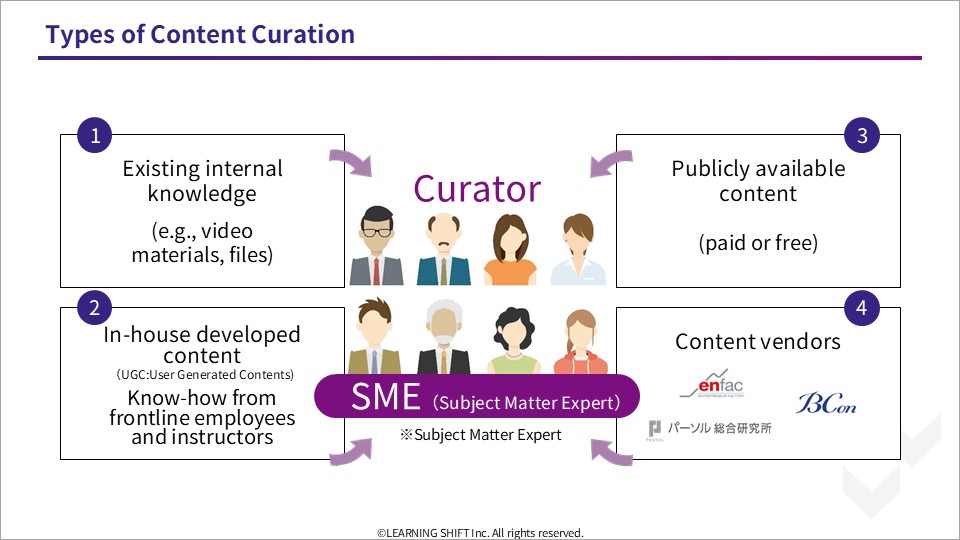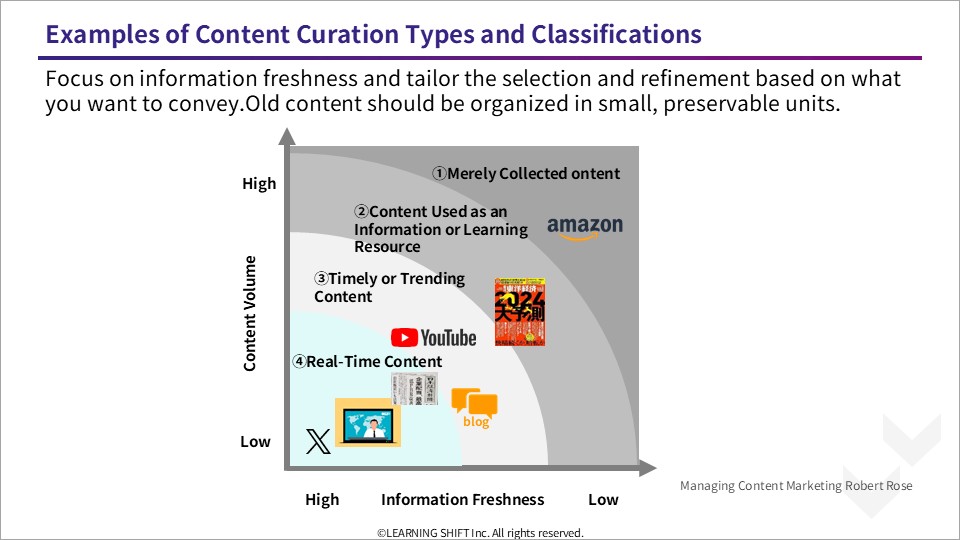2022.02.12
Is the Ideal Talent Development Manager a Curator? The Essential Role of Curation in Modern Learning

You might even question the fundamental role of a talent development manager. This is a natural concern because the responsibilities of talent development professionals are indeed evolving.
So, how is this role changing? One key concept that helps explain this shift is curation. This article explores the importance of curation in corporate learning, aligning it with the changing responsibilities of talent development professionals.
INDEX
- – What is Curation? Selecting, Organizing, and Editing Content Without Creating It
- – From Creator to Curator: The Changing Role of Talent Development Managers
- – Types of Content Curation
- – Informal Learning: The Dominant Form of Corporate Learning
- – Key Considerations for Implementing Curation
- – Conclusion: Leveraging Curation for High-Quality Content Development
1. What is Curation? Selecting, Organizing, and Editing Content Without Creating It
In the context of corporate learning, curation refers to one aspect of content knowledge, defined as follows:
“The practice of gathering, filtering, and organizing information from various sources based on a specific perspective to create new value.”
A helpful way to understand curation is to think about “curation websites” or “content aggregation sites.” These platforms collect and organize existing content in a meaningful way.
The individuals responsible for this process are called curators. They selectively gather information on specific themes and structure it in an optimal format. Today, curation has become a critical skill for talent development professionals.
2. From Creator to Curator: The Changing Role of Talent Development Managers
The role of talent development managers has shifted significantly, primarily due to technological advancements.
Traditional Responsibilities of Talent Development Managers
・Planning and designing training programs
・Creating learning content in-house or outsourcing content development
Previously, talent development managers focused on building training programs from scratch. However, given the rapid pace of change, it is becoming increasingly difficult to develop all required content in-house. This limitation has led to the rise of curation.
Relying solely on in-house content creation can delay learning opportunities. Meanwhile, a vast array of high-quality learning resources already exists. The concept of curation encourages leveraging existing content to deliver learning when it is needed, rather than insisting on creating everything from scratch.
Thus, the curation approach allows talent development professionals to blend high-quality content and deliver the most effective learning experiences at the right time.
3. Types of Content Curation
Curated content in corporate learning typically falls into the following four categories:

#1. Existing internal knowledge and resources
#2. Content developed in-house
#3. Publicly available online content
#4. Third-party content from vendors
Each type of content serves a unique role in corporate learning:
#1. Existing Internal Knowledge and Resources
This includes materials that already exist within the company, such as internal training videos, instructional documents, and recorded interviews with company leaders. Curating these assets helps transform them into valuable learning resources.
#2. Content Developed In-House
Also known as User-Generated Content (UGC), this refers to content created internally by employees. Examples include:
・Interviews with experienced employees sharing best practices
・Expert insights gathered through internal surveys
Content creation can range from simple smartphone recordings to professionally produced training materials.
#3. Publicly Available Online Content
This category includes freely available online resources, such as:
・YouTube educational videos
・Industry news and reports
・Expert articles and research papers
While some resources are free, others may require paid access.
#4. Third-Party Content from Vendors
Training providers and e-learning companies produce ready-made learning content, available through subscriptions or licensing agreements.
Although access may be limited, these professionally developed materials can provide high-quality learning experiences.
4. Informal Learning: The Dominant Form of Corporate Learning
Many assume that corporate learning consists solely of structured training programs. However, learning in the workplace is a mix of formal and informal learning experiences.
Employees gain knowledge through everyday experiences, including Google searches, conversations with colleagues, and problem-solving in real-time. These activities represent informal learning, which plays a crucial role in professional development.
The 70:20:10 Learning Model
A study by the Lominger Group identified a key learning distribution pattern:

①70% of learning comes from on-the-job experiences (informal learning)
②20% comes from interactions with colleagues and mentors (informal learning)
③10% comes from formal training programs
This means that 90% of effective learning happens informally. Organizations must consider both formal and informal learning when designing learning strategies.
Since the previous section on content curation focused mainly on formal learning, it is essential to recognize informal learning as a key area for curation.
5. Key Considerations for Implementing Curation
A curator’s role is to collect, refine, and distribute high-quality content at the right time. To be effective, curators must develop the ability to efficiently gather and process information.
Based on this, here are two practical points to keep in mind when curating content:
- Select and refine content from two perspectives: content quality and information freshness.
- Continuously collect information from both internal and external sources.
1)Content curation can be grouped into three types, based on quality and freshness.
1.Content available within the organization or newly created internally
2.External content from free or paid sources
3.Everyday learning experiences
While content is selected and refined as needed from these categories, it’s also important to consider another classification—content types based on the freshness of information.
Taking this additional perspective into account helps ensure the curated content remains timely and relevant.

1.Static reference materials (e.g., archived reports)
2.Learning resources (e.g., online courses, case studies)
3.Trending and news-based content (e.g., industry updates)
4.Real-time content (e.g., social media updates)
The higher the freshness of information, the smaller the amount of content tends to be. Conversely, as the freshness decreases, the volume of content generally increases.
For example, X delivers the latest information in real time, but each post is limited to 140 characters—making it relatively low in content volume.
On the other hand, books tend to contain a larger volume of content, with systematically organized topics, though the information is less time-sensitive.
It’s important to note that high information freshness does not necessarily mean high content quality.
Understanding the characteristics of each content type and choosing appropriately based on your message is key.
2) Continuously Collecting Information from Internal and External Sources
The second key point is to continuously collect information from both inside and outside the company, while keeping in mind the two perspectives explained earlier.
What’s essential for effective content curation is speed and information volume.
Always stay alert to internal and external changes.
You can use tools to gather information from social media or catch trending topics, but just as important is asking people who are familiar with the field—because it’s often much faster than researching on your own.
In particular, for informal learning, which makes up most corporate learning, it’s important to stay connected to the workplace and understand who has what knowledge internally.
The information you gather by directly engaging with people becomes valuable material for new content.
6. Conclusion : Leveraging Curation for High-Quality Content Development!
The five key content types used in curation are:
①Existing internal knowledge and resources
②Content developed in-house
③Publicly available online content
④Third-party content from vendors
⑤Informal learning experiences
Since 90% of corporate learning is informal, talent development managers must curate not only formal training but also real-world learning experiences.
By systematically collecting, filtering, and organizing content, organizations can enhance learning effectiveness and develop a culture of continuous learning.